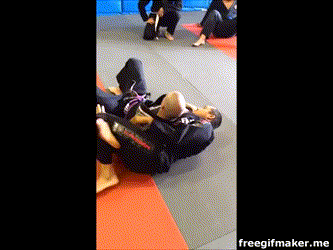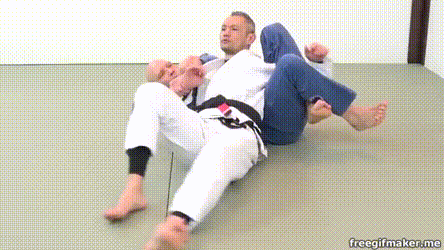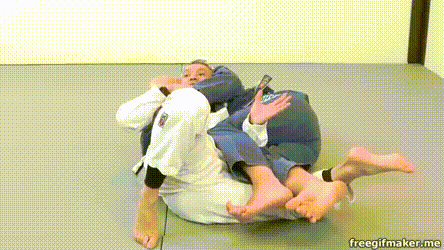
The back control position is considered to be the most dominant one in Brazilian Jiu-Jitsu. While there, you have the opportunity to control both your opponent’s hips and shoulders from a position of total safety. It is also a great position to set up attacks that are very difficult to defend. In terms of back control, there are a few variations that offer either greater control or greater submission opportunities. One such position that is quite underrated in grappling is the BJJ crucifix position.
The BJJ crucifix position can be used as a great way to attack an opponent while he is in turtle. It can also be another way of attacking from the back position. The control and the easy submissions that come from that position make it that much more favorable. In terms of control, it lacks the hip control that the back position has, but doubles up on shoulder control instead. And, while there aren’t a ton of submissions from there compared to other positions such as closed guard or mount, the subs that are available work exceptionally well.
First of all, we’ll mention the NEW Alexandre Vieira DVD – The Crucifix and Loop Chokes. If you’re interested in loop chokes of all kind and also the crucifix position I must say there is no better instructional anywhere around then Alexandre Vieira DVD is. It’s an instructional with so many techniques (check techniques list) and so many options to get the loop choke from any position that it’s a real game changer. I won’t even mention the crucifix position because Alexandre showed the ways of getting there so easy that it’s almost impossible to defend it. Make sure you check it HERE if you’re interested in crucifix position and loop chokes.
BJJ Crucifix Attack System
Before we get into the various submissions that can be launched from the BJJ crucifix, let’s look at some ways to enter into the position. There are a few common scenarios that you will find yourself and your opponent or training partner in, that will allow you to enter into the BJJ crucifix position. In the simplest terms possible, the goal is to try to pin one side of the opponent’s body. To do so you’re going to use your legs and hips to control one side of their upper body. The opposing side of their upper body is under the control of your arms and your own upper body. Once the opponent is controlled, you can begin working the various submissions options like chokes and arm locks.
Like most every technique in Jiu-Jitsu, it’s important to have both your upper and lower body working in unison. In the case when the opponent turtles up, you must think about what to do with both sides. The far leg, must trap the near side arm of the opponent and begin to separate it from their torso. Simultaneously, you’ll need to secure control of the opponent’s other side to prevent escapes. You can do this by controlling their wrist, which prevents them from making a strong base when you try to take them over. This also sets the stage for the upcoming submission attempts.
Crucifying The Turtle
The turtle position can be one of the most difficult positions to break through because of the ultra-defensive positioning the opponent is using. Elbows are tight. Many times there is no way to get a knee or hook into their hips. Without that, there’s no hope of breaking down the position. Many BJJ players tend to focus on the lower half of the opponent’s body to try to control the hips and ultimately become frustrated when they can’t break through. By attacking the upper third of the opponent’s body with the BJJ crucifix position, you can open many new doors. From there, you can begin to submit your opponents. The BJJ crucifix is going to help you spend much less time beating your head against the impregnable shell of turtle defenses.
Submission Chains From The BJJ Crucifix
With the crucifix, you get what known as a dual attack. That’s where you’re applying two attacks at the same time. As you’re controlling the person with the crucifix, you have both armbar variations and choking options immediately available to you. The beautiful thing about a dual attack is that your training partner won’t know which attack to defend.
Crucifix Chokes
Since the BJJ crucifix is just another version of the back control, the first go to submission from there is obviously the rear naked choke. Once in the BJJ crucifix position, you must put your free hand into action right away. Taking your free hand, you must use the “blade” of your wrist and forearm to go underneath your opponent’s chin, going relatively deep in on the neck. When he goes to defend against your hand, take your hand that was controlling his shoulder and get a palm to palm grip, popularly known as a Dan Severn grip, and squeeze in. This is a strong choke that can end a match abruptly.
The setup and attack for this collar choke are the same as the rear naked choke. Usually done rolling from the turtle, you will control your opponent’s far shoulder with your legs, and his close shoulder with your arm. With your free hand, you must use the “blade” of your wrist and go underneath your opponent’s chin and get a deep grip on his collar. Once you have that grip, you must use your arm that is controlling his shoulder. Shoot that arm up and behind his head. Pull the collar and apply pressure with your hand behind his head. It’ll be time to tap.
This variation of a collar choke from crucifix position is called “Jigoku Jime” – translated as the Hell Strangle. It is a very powerful choke as you use your leg to apply big pressure.
Armlock Attacks
One way in which grappling martial arts practitioners can leverage this position is by attacking the opposition with an armbar. What is normally a pretty effective hold, it gets a little more complicated when you begin to factor in the BJJ crucifix position. Let’s take a closer look as to how you can properly execute the crucifix armbar, and start scoring some slick looking submissions!
Many experts say that the back position is the most offensive position in BJJ. However, there are certainly flaws in this position. Many people find it difficult to finish the rear naked choke in the conventional back position. In BJJ tournaments, taking the back and putting your hooks in is critical for getting points.
Like most positions in BJJ, there are many variations and many different ways to control an opponent and the back position is no different. The crucifix is a variation on the back take that takes both arms out of play so that the only thing the person can do to defend is to drop their chin in an attempt to protect their neck.
Keep learning and keep improving, and there’s no telling how quickly you will progress up the ranks in Jiu-Jitsu! Now enough reading, go give the crucifix a try and let us know how it works!
BJJ Crucifix Defense System
If you asked me which position in really deeply hate defending against I’d have to say it was back controlled. Having someone behind you makes finding ways out that more difficult. Even leg locks are easier to deal with than having a human backpack trying to strangle you from behind. To this day, I do not particularly enjoy getting out of back control, so I try to prevent it the best I can. That said, there’s one back control variation that I’d bet most grapplers utterly hate. At least when they’re on the receiving end. Back control defense is not easy, and crucifix defense is even harder. In fact, getting out of the crucifix position might be the greatest Houdini act in Jiu-Jitsu! Now, it’s time for you to learn how to perform it!
If you take a look at some of the world’s most proficient grapplers, you’ll easily notice a common pattern. Marcelo Garcia, Felipe Pena, Cobrinha etc, all have the tendency to hunt for the back. Back control does bring an immense amount of control along with direct submission options. In fact, it also brings 4 points in most competition formats, which is the most you can get from a single position. Escaping is hard, even when you’re in the basic seatbelt and hooks control. Crucifix defense is a whole different can of worms, but it is absolutely necessary for you to know at least one.
Why should you be so focused on learning a crucifix defense? Well, first of all, the crucifix position is like back control on steroids. Secondly, even more, submissions and even striking options are readily available. And last but not least, even though your hips are free, getting out is nearly impossible against a well-versed opponent. So, figuring ways out of a position that has you trapped, powerless and gives your opponent multiple ways to finish you is not just a good idea, it is a priority!
The Power Of The Crucifix
The crucifix position is one of the most brutal positions in Brazilian Jiu-Jitsu. In fact, it is one of the most notorious positions in all of grappling martial arts and even MMA. The main problem with the crucifix position is the incredible amount of control over your upper body. Even though it may seem your opponent is barely hanging on, there’s absolutely no way to free your hands. Unless you create one, of course.
The crucifix position has you behind an opponent, controlling one arm with a Kimura grip, and the other with a triangle made with your legs. The power of the position lies in the fact that it offers control over both shoulders. The reason why control is so tight is that there’s no way to either pull or rotate your arms out. In fact, you’ll hardly even be able to bend or extend them unless the opponent allows it.
Getting there is also not hard at all. Feeling comfortable defending chokes from the back? Well, once you get caught in the crucifix a few times you’ll reconsider how comfortable you are. Getting there fro regular back control is a breeze. there are also very nasty ways of entering the crucifix from the turtle or the front headlock. In both cases, there are even more options for submission.
Speaking of submissions, name your favorite. the only thing missing are leg locks, and they’re actually not that far away. Arm locks and chokes are the usuals but there are also nasty neck cranks and ultra painful wrist locks. Now it is clear why you need a crucifix defense if you’re to become a good grappler.
High-Level Crucifix Defense Principles
Before we begin discussing crucifix defense, let’s make something clear. You can fight against the position until a certain point. Once you’re past the point of no return, you’ll get submitted, This is crucial to understand in order for you to know when you should tap. The crucifix defense options we’ll explore today work against the position, not fully locked submissions.
Learn some crucifix setups, attacks, and even defenses, from a true master of the position. Alexandre Vieira’s “Crucifix And Loop Chokes” DVD set is a unique piece of digital instructions. Get it while it is still on sale!
An Ounce Of Prevention
In order to stay safe, you need to understand that the weak spot of the crucifix is only during its establishment. Since in most cases, people are going to have control over one arm. preventing them from getting the other is essential.


Last Gasp Crucifix Defense
This crucifix defense is as last second as it can be. it utilizes the fact that your opponent releases one of your arms in order to get to your neck. At this point, an experienced opponent is already very near a choke so you’ll need to act really quick.


A Comprehensive Guide To All BJJ Chokes
How To Choke The Turtle With A Peruvian Necktie
The Rear Naked Choke From Hell
Subtle Tricks For Developing World-Class BJJ Chokes












































